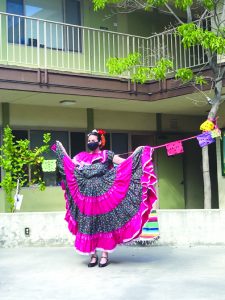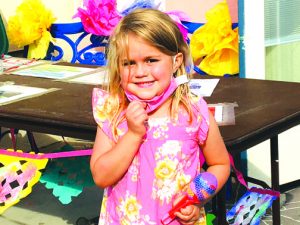
Photo by Lori BODNAR
By Lori BODNAR, intern
Cinco de Mayo was celebrated locally in grand style by nearly 70 students and their teachers at the Center for Children at La Crescenta Presbyterian Church (LCPC). The group welcomed Grupo Folklórico de USC that performed traditional Latin American dances in an outdoor courtyard on May 5, a special day to recognize Mexican culture, achievements and experiences. The Cinco de Mayo holiday, also known as Puebla Day, originated from the Mexican army victory over France at the Battle of Puebla on May 5, 1862.
Dancers in Grupo Folklórico wore vibrantly colored traditional costumes and performed several cultural dances, including the Mexican hat dance, to entertain the audience. Students from preschool through elementary school were enthralled by the performers’ twirling and dancing. The students enthusiastically clapped and played along to the Latin music, shaking homemade maracas they had fashioned by enclosing rice or beans inside a plastic egg then taping on two spoons to make a handle. Some students wore artfully decorated sombrero hats they had crafted using paper plates, paper bowls, crayons and string.

Grupo Folklórico was reestablished at the University of Southern California in 2018. Samantha Nuñez has been in the folk dance and music group at USC for almost three years and is the president of the club. The instructor advisor is Dahlia Monroy. Other Grupo Folklórico members include Ivonne Rodrígez, Adriana Sanchea and Leaha Villaread. Several of the performers were graduating this year from USC, so the opportunity to perform for a live audience was especially poignant.
“Grupo Folklórico de USC allows us to express our culture and become closer as a community at USC,” said Samantha Nuñez. “We get to create space for our culture on the campus that is so diverse.”
Grupo Folklórico de USC performed the popular Mexican folk dance “Jalisco,” which includes jumping by the dancers to represent the galloping of horses.
“The Latin American dances are based on agricultural movements so the dances depend on the land and region we are representing,” Nuñez said.
Grupo Folklórico de USC has also performed at the beach as well as performing virtually. They host a biannual showcase on the USC campus for the USC community and the surrounding area to share and appreciate Mexican culture, including traditional folk dance and music.
LCPC held the event to showcase different cultures to the children. LCPC Center for Children director Pat Chambers said, “We like to take opportunities to expose the children to different cultures. We asked for help with showing Latin cultures and Grupo Folklórico de USC helped us with that.”
The Center for Children serves children and infants from ages 6 weeks through those in sixth grade. They have both in-person and distance-learning options, and opportunities for full-time or part-time care, such as after-school programs, including enrichment activities and summer day camps. For more information, visit the website https://www.center4children.com/. All children are welcome to attend; they do not need to be members of the La Crescenta Presbyterian Church. The Center for Children has been serving children since 1967, and the La Crescenta Presbyterian Church was founded over 135 years ago, in 1886 when Dr. Benjamin Briggs donated property and church members living in the Crescenta Valley organized a congregational church.
Precautions were taken to reduce the spread of COVID-19 at the outdoor event including taking the temperatures of attendees and dancers through a non-contact thermometer and everyone wore masks.
The young students seemed to enjoy the performance by Grupo Folklórico de USC.
“I like the dancing. It was like Disneyland dancing!” said Lorelai Moses, 4.
Craig Work is 6 years old.
“I enjoyed the dancing and the music,” said Craig. “It was fun!”
“My favorite part was when the dancers spin!” said Charlotte Eckerlin.

Photo by Suziy BODNAR
The students also learned about the Mexican culture by making papel picado for decorations. Papel picado, or “perforated paper,” are paper banners made by cutting artistic designs into tissue or other paper. Papel picado is considered a Latin American folk art tradition and the decorations were used at the outdoor courtyard of LCPC.
